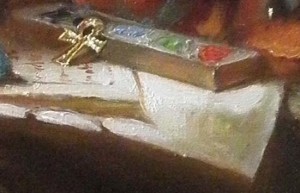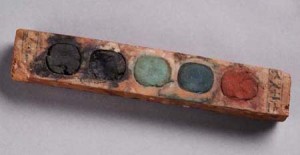This detail of the same painting shows a chunk of malachite similar to those found in the Egyptian rooms at the Smithsonian. I thought it fitting to portray the mineral as the ancients would have found it before it was ground into a pigment. … [Read more...] about Details Please
Lessons from the Pharaoh's Tomb 2
A continued exploration of pigments from Egyptian antiquity, featuring additional imagery, myths, events, colorful stories of gods and goddesses, and Pharaohs dating from 3500 BCE.
From the Vizier’s Studio
This detail of one of the finished Part ll Project paintings shows how the vizier's paintbox might have looked in his studio. The colors in the box, red iron oxide, malachite, yellow, and black were all used in my painting just has he most likely would have used. Writings below the box are on papyrus. … [Read more...] about From the Vizier’s Studio
The Vizier’s Paints
Paint Box of Vizier Amenemope Egypt, New Kingdom, Dynasty 18 (1540-1296 BC), Reign of Amenhotep II, c. 1427-1401 BC. Boxwood with inscription inlaid in Egyptian blue, 3.6 x 2.2 x 21.0 cm. © The Cleveland Museum of Art Gift of the John Huntington Art and Polytechnic Trust 1914.680 Image Courtesy of Cleveland Museum of Art. This … [Read more...] about The Vizier’s Paints
Don’t Shoot the Deputy
A vizier in ancient Egypt is similar to a consigliere in the modern day Mafia, a deputy, a right hand man to the big boss, specifically the Pharaoh. Remember Robert Duvall as Tom Hagen, Don Corleone's voice of reason in the Godfather? How about FDR's Harry Hopkins. Well that would be the role of the vizier. He advised his boss in everyday matters … [Read more...] about Don’t Shoot the Deputy
When I Grow Up, I Want to Be an Art Forger
Now I do not aspire to go underground or "non-legit" with my painting techniques, but art forgery is quite a fascinating topic. One of the best ploys Eric Hebborn suggests is to purchase an artistically worthless old painting, say, from an antique shop or art auction. Wood panel or canvas, each would be naturally aged and seasoned, ready to scrape, … [Read more...] about When I Grow Up, I Want to Be an Art Forger
Arsenic in the Stew
Orpiment, shown above in its natural form and also pigment form, was widely used in Egypt during and after the 18th dynasty, about 1500 BC. During this period the very progressive and successful female pharaoh, Hatshepsut, was in power. It is thought that she initiated trade with other countries and the use of orpiment began because of her. Because … [Read more...] about Arsenic in the Stew






